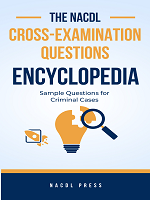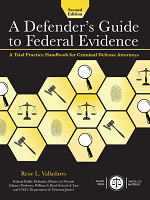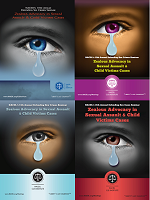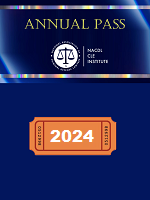Access to The Champion archive is one of many exclusive member benefits. It’s normally restricted to just NACDL members. However, this content, and others like it, is available to everyone in order to educate the public on why criminal justice reform is a necessity.
It
has been two years since NACDL released a seminal study that focused on
the burgeoning drug court phenomenon. The report, America’s
Problem-Solving Courts: The Criminal Costs of Treatment and the Case for
Reform, fundamentally challenged the growing national acceptance of
drug courts.1 For the first time, a major investigation conducted under
the auspices of the criminal defense bar documented flaws in what many
had perceived as a universally popular and effective alternative to
lengthy incarceration.
NACDL based its report upon hearings conducted around
the country. The task force received testimony from an array of
stakeholders, including defense lawyers, prosecutors, drug court
professionals, judges and ex-addicts.2 It found a widely disparate
approach to drug courts. A few featured open admissions, did not require
irrevocable waiver of rights, and carried minimal negative consequences
for failure in treatment. But those were the exception.
All too often, drug courts denigrate fundamental
rights, extracting broad waivers as the cost of admission, and expose
even the most well-intended to dire consequences, often worse than if
they avoided drug court and simply pleaded guilty. They tend to place a
premium on early guilty pleas, thereby insulating questionable law
enforcement search and seizure practices, and provide a convenient means
for prosecutors to shed defective cases. And some drug courts impede
the attorney-client relationship and undermine an accused person’s Sixth
Amendment right to a vigorous defense. Worse, many drug courts operate
without transparent admission criteria, and most bar eligibility to
recidivists and those most in need of treatment. These factors tend to
exacerbate racial and economic disparities in the criminal justice
system.
NACDL’s report spawned a great deal of discussion.
While some commentary has been critical, others are beginning to take a
second look at drug courts and whether this approach is the best
solution. On March 22, 2011, two new reports were released, both of
which confirm NACDL’s concerns.
The Justice Policy Institute (JPI) issued Addicted to
Courts: How a Growing Dependence on Drug Courts Impacts People and
Communities. The report makes the case that drug courts not only widen
the net of criminal justice control, but they are less cost-effective,
less fair, and no more successful in treating addiction.3 The report
identifies several of the same problems NACDL detailed in its earlier
report — “cherry picking” of those most likely to succeed, increased
racial and economic disparity, and harsher outcomes for those who try
and fail to complete drug court treatment programs.
The Drug Policy Alliance (DPA) released Drug Courts
Are Not the Answer: Toward a Heath-Centered Approach to Drug Use. The
DPA’s report finds that drug courts have not demonstrated cost savings,
reduced incarceration, or improved public safety. In fact, the report
finds that drug courts leave many worse off for accepting that approach
and have made the criminal justice system more punitive toward
addiction.4 The DPA report asserts that there is an urgent need for a
non-criminal, health-centered approach to drug use, and cites a wide
range of data to support the contention that such an approach saves a
fortune and reduces crime.5
NACDL members and others with an interest in this
subject should read these illuminating reports in their entirety. They
both survey a plethora of data, research, and publications on this
vitally important public policy issue. Taken together, they provide
important support for NACDL’s core position that addiction and the crime
it causes, including possession and low-level distribution to support
addiction, cannot be addressed by the criminal justice system. The DPA
report underscores the magnitude of the problem. In 2009, 21.8 million
people, which is 8.7 percent of the population over age 12, reported
using illicit drugs.6 With about 7.8 million of those surveyed
indicating that they need treatment, the DPA report notes that this
represents more potential patients than those suffering from lung,
breast, and prostate cancer combined.7 It borders on the delusional to
think that a criminal justice system can address this need. But that has
been the nation’s primary approach. Each year police make more than a
million arrests for drug offenses, and hundreds of thousands are sent to
our nation’s jails and prisons. The direct social and economic costs of
these policies are staggering. The indirect costs that flow from the
stigma of conviction and the attendant collateral consequences cannot
possibly be calculated.
Let there be no mistake. Drug courts have helped many
people. They have saved lives. They have probably saved hundreds of
thousands of prison years. For clients facing a lengthy prison sentence,
even a long shot at successful diversion must be considered. And
therein lies the dilemma. As long as draconian penal policies drive
America’s drug policy, drug courts will thrive — irrespective of their
flaws.
The JPI and DPA reports both cite a report finding
that over 55,000 enter drug courts annually.8 This number represents
only a tiny and select percentage of drug defendants. But if drug courts
can only treat a sliver of those who need help, if they perpetuate
inequity, reject the individuals most in need of treatment and divert
precious resources toward a dead end solution, then they are not the
answer. Drug courts may be a stop-gap measure that allows some to avoid
harsh prison sentences and others to recover and end the cycle of
self-destruction and despair. But they are no substitute for a long-term
solution.
NACDL has long believed that addiction to any
substance, whether legal or illegal, is really a health problem best
treated by the medical community.9 The Association reiterated that view
when it released its report on problem-solving courts. At the same time,
the report listed a panoply of reforms that would make the drug court
approach fairer and more widely available. With little progress toward
real reform and the release of these new reports urging a public health
approach, it is time to underscore NACDL’s fundamental position: drug
abuse and addiction are health problems. They are not criminal problems.
Drug abusers are someone’s sons and daughters, brothers and sisters,
colleagues and neighbors. They are not inherently bad or evil. They are
not criminals, and they should not be treated as such. A serious
national conversation about the merits of decriminalization is long
overdue.
Notes
1. The report, which was adopted by NACDL Board of
Directors on August 8, 2009, was the work of a task force that included
Adele Bernhard, Jay Clark, Rick Jones, Elizabeth Kelley, Marvin E.
Schechter, Gail Shifman, and Vicki Young. Professor Joel M. Schumm of
the Indiana University School of Law served as the reporter. The report
may be found at www.nacdl.org/drugcourts.
2. A link to the hearings transcript can be found at www.nacdl.org/drugcourts.
3. JUSTICE POLICY INSTITUTE, ADDICTED TO COURTS: HOW A GROWING DEPENDENCE ON DRUG COURTS IMPACTS PEOPLE AND COMMUNITIES (2011).
4. DRUG POLICY ALLIANCE, DRUG COURTS ARE NOT THE
ANSWER: TOWARD A HEALTH-CENTERED APPROACH TO DRUG USE (2011)
[hereinafter DPA REPORT].
5. DPA REPORT at 22.
6. DPA REPORT at 1, citing OFFICE OF APPLIED STUDIES,
SUBSTANCE ABUSE AND MENTAL HEALTH SERVICES ADMINISTRATION, RESULTS FROM
THE 2009 NATIONAL SURVEY ON DRUG USE AND HEALTH (2010).
7. DPA REPORT at 1.
8. A.S. BHATI, J.K. ROMAN & A. CHALFIN, URBAN
INSTITUTE, JUSTICE POLICY CENTER, TO TREAT OR NOT TO TREAT: EVIDENCE ON
THE PROSPECTS OF EXPANDING TREATMENT TO DRUG-INVOLVED OFFENDERS (2008).
9. National Association of Criminal Defense Lawyers,
Board Resolution to End War on Drugs (Nov. 4, 2000); read the resolution
on the Press Room page at www.nacdl.org.






